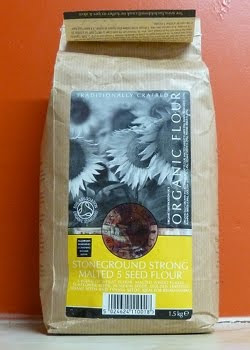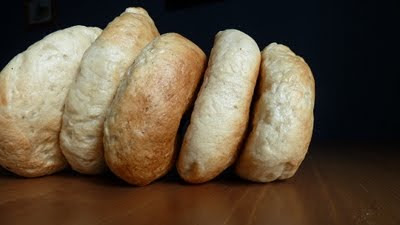To start the day, Clive handed round examples of breads that he'd made by different methods. It was lovely to see him slice them open to reveal the inside, then pass it round so that we could smell it and see and feel the texture. The variety and textures were brilliant to see and compare, and I'm sure I wasn't alone in aspiring to produce something that good as I followed with my eyes each loaf that I passed on.
We started our own baking with a white dough using a sponge (a basic white dough left to ferment and stored in the fridge). Clive referred to the ingredients using the baker's percentage (expressing each ingredient as a percentage of the mass of the flour used). I'd seen this used in various recipes but had found it strange and was reluctant to tackle it, so it was really helpful to see this approach in action. Although it requires a bit of mental agility, it frees you from a written recipe and makes it so much easier to scale your quantities. He also talked about taking control of the process and how you can adapt variables like temperature and added ferments and time to help you to do this.
Working this dough involved tearing it, using the heel of the hand to stretch it away along the bench, then rolling it back up again. This was very different to how I'd been working my dough at home but was easy to get the hang of and although I'd been concerned that it would feel like I wasn't incorporating enough air, the rolling back up was certainly doing this. Folding the dough was similar to what I'd learned before, but the moulding action was new to me - with hands flat on the bench, palms up, you bring them in close to each other at the base of the dough, sliding one away from you and one towards you, twisting the base of the dough - creating tension and a neat rounded form. With this dough we made a cottage loaf (my first ever), pittas and a plaited loaf (mine suffered a bit of a collision with the back of the oven as a consequence of some rather overenthusiastic peel wielding). The pittas cooked quickly and elicited oohs and aahs from the group peering through the oven door as our breads inflated beautifully before our very eyes. Pittas are the one bread I still buy in the shops - but not, I think, for much longer...
We made a soda bread with coarse brown flour, sunflower seeds, herbs and feta. These were the first out of the oven, and a collective swell of pride in the room was almost tangible, the results looked so good. Each had a cheeky little paper tag poking out of it to identify its creator. 'So that nobody can disown theirs, ' smiled Clive - but nobody wanted to disown any of them.
The next dough was a sweet dough for Chelsea buns, using a flying ferment to get things going so that the yeast had a chance against the retardant effects of the sugar and butter. This was very sticky work, mixing the ferment and the main dough by hand and squishing in the butter. The proud-o-meter in the room rose a notch or two when those beauties came out of the oven and we finished them off with a quick brush of runny icing.
Finally, we used an emulsifying method of preparing the non-flour ingredients for a sweet shortcrust pastry, producing a paste which could be handled and re-handled without danger of the water and gluten interacting. I think I might finally have found a way that I can make good pastry!
Lunch was a delicious sampling of the breads Clive had shown us first thing, allowing us to compare even more closely the texture, smell and taste. The rye with figs was extremely popular.
Included in the day was a tour of the mill, a fascinating journey from the testing done before a delivery of grain is accepted, to the final bagging and despatch of the sacks.
The last hands on operation before assembling our goodies and making our way home was the feeding of Clive's sourdough mothers - a white and a rye. Once they were snoring after a good feed, he generously gave us a portion of each to take home - so all my agonising about how to get one going for myself was completely unnecessary. Perversely, just before I left for the course, I saw that the starter I'd attempted had caught, and was bubbling happily. With three to juggle, I can see that I've got scope for a lot of experimentation over the next few months, and I'm starting to wonder what happens if you mate a couple...
I had a tiring but brilliant day, learned a huge amount about flour and how to work with it, enjoyed myself immensely, made bread that I'm very proud of, and was once again hugely impressed at how well a good kitchen works. Everything was to hand, used stuff was tidied away instantly, the bench was cleaned and tidied at every opportunity and it all just worked like clockwork. This was in no small way attributable to Washing-Up Fairy Lesley who not only washed and dried but kept us going with tea and lots of smiles.
As I drove home I reflected on the day and the very great pleasure that there is to be had in watching an expert doing what they love - the fluid, assured movements and handling of materials, the unhurried pace and the wonderful results. I loved, too, Clive's clear enjoyment in sharing with others and seeing them grow in confidence and skill.
Big thanks to Clive and Lesley and everyone else at the Mill for a fantastic day full of information, hard work and good humour which has left me happy and proud and with a head full of possibilities.



















































